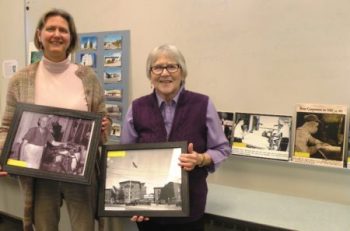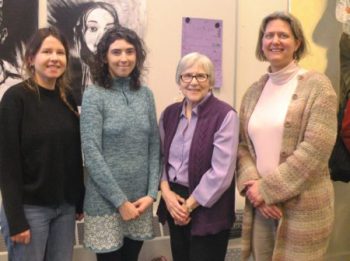An informational forum with lunch to hear about Augusta’s manufacturing history featured oral histories from the workers who were employed in the capital city’s once bustling mills. In fact, the program was a Franco-American learning opportunity, hosted by the French Club, held on February 11, at the University of Maine Augusta (UMA), at the Holocaust and Human Rights Center, located on the campus.
I always come away with new information when I’ve attended the past UMA hosted lunch programs and the presentation about Augusta’s manufacturing history was no exception.

Merci to the French Club!
Hearing the oral histories on video, about working in the Augusta mills, had the effect of putting the forum attendees back in time. The workers described the experiences of doing repetitive, and demanding jobs that required their focused attention and tested their endurance.
In the past, Augusta Maine was the location of several manufacturing companies where thousands of people in the community were hired to provide labor. Sometimes, even child labor. Most of the workers were Franco-Americans, who came to the Augusta area. They were among the thousands of families who had immigrated from French Canada, primarily Quebec.
Jan Michaud, the Executive Director of the Heritage Center at Mill Park, a cultural restoration program, presented the video program. Michaud led the organization to preserve the legacy of the Mills, and to tribute the Franco-Americans who lived in Augusta and worked in the factories.
“Manufacturing Augusta”, was filmed with workers who were interviewed about their experiences working in the city’s mills, that were once located along the Kennebec River and in Mill Park, adjacent to the river. Today, the area includes a lovely park.
Chelsea Ray, the Assistant Professor of French and Comparative Literature at the University of Maine Augusta (UMA) and the French Club President Sara Nichols, hosted the program.
French students and community members attended. Special guest Lisa Quinquis, a student from France who is studying at UMA this year, attended the program.
Merci pour le délicieux déjeuner!

Following is a list of the mills featured in the video and a summary provided by Mrs. Michaud:
- Edwards Mill, a cotton mill founded in Augusta, Me., in 1845; purchased in 1868 by Sprague Manufacturing Company and in 1883 by Edwards Manufacturing Company, which greatly enlarged the plant; employed thousands of people and became a major producer of clothing during World War II; in 1945 purchased by Bates Manufacturing Company and became known as its Edwards Division; later buildings were purchased by the Augusta Development Corporation in order to prevent the company’s closing. The plant was destroyed by fire in 1989 but the land and the adjacent dam held by Edwards until 1999, was transferred to the state in order to restore the Kennebec River fishery. Cite as: Edwards Manufacturing Company (Augusta, Me.). Records, 1882-1948.
- The Kirschner Meat Processing Plant
- Taylor Shoe Company
- Hudson Pulp and Paper
At my request, Mrs. Michaud sent this synopsis about the presentation:
Hi Juliana, Thank you for coming to see our ’short clip’ at UMA.
The manufacturing companies that were on the 17 acres of land on the western side of the Kennebec River was Bates Manufacturing Edwards Division. In 1882 Jacobs Edwards bought the mill. In 1945 Edwards Manufacturing merged with Bates Manufacturing. During WWII employment reached 3000,and ran three shifts. The mill was so large that its building covered the 17 acres. The mill workers were also responsible for keeping Edwards Dam free from debris. Spring time was especially difficult to keep the dam clear of winter debris. Manufacturing at Bates Edwards Division in 1983 left a skeleton work force of 50 workers. Its doors close in 1984. A massive fire destroyed the cotton mill on November 30, 1989. The huge fire burned for the entire first week of December.
Directly across the river was the Hudson Pulp and Paper Mill, which faced the Cotton Mill. The Paper Mill had several owners over the decades including, in 1938, the Kennebec Pulp and Paper Co., Hudson Pulp and Paper in 1972 and Statler Tissue, which closed in 1995, among others.
Kirschner Meat Processing Company started on Water Street in downtown Augusta in the late 1920’s. As their business grew, the plant moved to Bangor St., on the East side of the river. They employed two to three hundred people. My sources come from the Kennebec Historical Society Historical Events and the Kennebec Journal 1989.
Shoe manufacturing histories presented were told by former workers at the Taylor Shoe Co., which stood on the west side of the river, next to Old Fort Western, on the west side near Memorial Bridge.
Friends for a Heritage Center at Mill Park, Inc. has been a non-profit corporation since February 7, 2010.
For information about the Franco-American forums hosted at UMA and the French Club, contact Professor Chelsea Ray at email chelsea.d.ray@maine.edu.

